Facial aging is a deeply complex and multifactorial process, and understanding and preventing facial sagging is essential for those seeking to maintain youthful skin health over time. Many individuals notice early changes in their facial contours, leading to the often-asked question, “Why is my face sagging at 20 or 30?” Far from being purely cosmetic, sagging facial skin is linked to underlying biological, lifestyle, and environmental factors. In this essential guide, we explore the intricate mechanisms behind facial sagging, why it can happen earlier than expected, and most importantly, what proactive measures can be taken to delay and possibly even reverse these visible signs of aging.
You may also like: How to Tighten Loose Skin After Weight Loss: Science-Backed Strategies for a Firmer, Healthier You
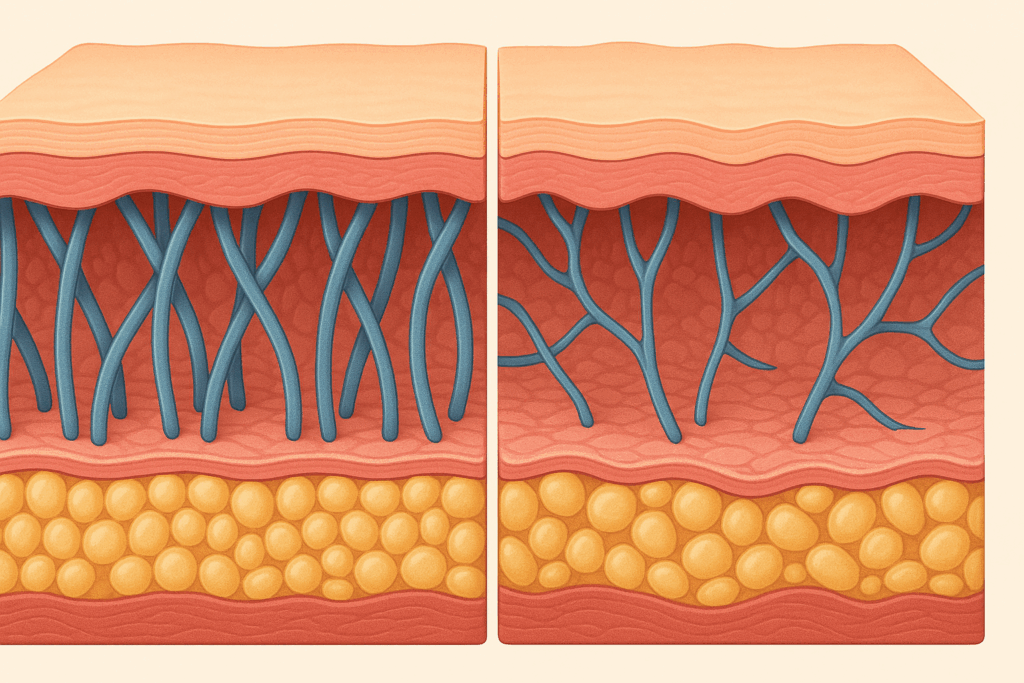
What Causes Sagging Skin on the Face?
Sagging facial skin is not merely the result of aging alone. While chronological aging plays a pivotal role, the decline of collagen and elastin—the structural proteins that maintain skin firmness—is central to this phenomenon. The dermis, or middle layer of the skin, is rich in these proteins in youth, granting the face its plump, resilient quality. Over time, however, production of collagen decreases by approximately 1% each year after the age of 20, leading to a loss of skin elasticity.
External factors, notably UV radiation, pollution, and smoking, also accelerate collagen degradation. Photoaging, induced by cumulative sun exposure, introduces oxidative stress that damages the DNA of skin cells and reduces fibroblast function. Additionally, lifestyle factors such as poor nutrition, inadequate sleep, chronic stress, and high sugar intake can all contribute to the breakdown of collagen and elastin, making the skin more prone to sagging.
Furthermore, the natural loss of facial fat and bone density with age leads to volume depletion. The underlying scaffold that once supported youthful skin diminishes, creating hollow cheeks, saggy jowls, and a generally “mature and saggy” appearance. Understanding these underlying causes provides a roadmap for targeted interventions in preventing facial sagging effectively.

Understanding and Preventing Facial Sagging: The Role of Genetics
When exploring the reasons behind “why my face sagging” earlier than peers, genetics emerges as a significant influence. Inherited traits can determine skin thickness, collagen density, facial bone structure, and fat distribution patterns—all of which collectively influence the resilience of facial contours over time. Some individuals naturally produce less collagen or have skin types more prone to environmental damage, thus facing an earlier onset of sagging facial skin.
Genetic predisposition also affects the onset of forehead sagging and the development of saggy cheeks. Families with a history of early facial sagging often experience these signs in their twenties or thirties, sparking concern among younger individuals who feel their appearance does not match their chronological age. While genetic factors cannot be altered, their impact can be mitigated through early, personalized interventions.
By combining understanding of genetic predisposition with modern anti-aging strategies, such as preventative skincare, sun protection, and medical-grade collagen stimulators, it is possible to significantly delay the visible consequences of these inherited tendencies. Recognizing that genetics is a piece—but not the whole—of the puzzle empowers individuals to take control of their facial aging trajectory.
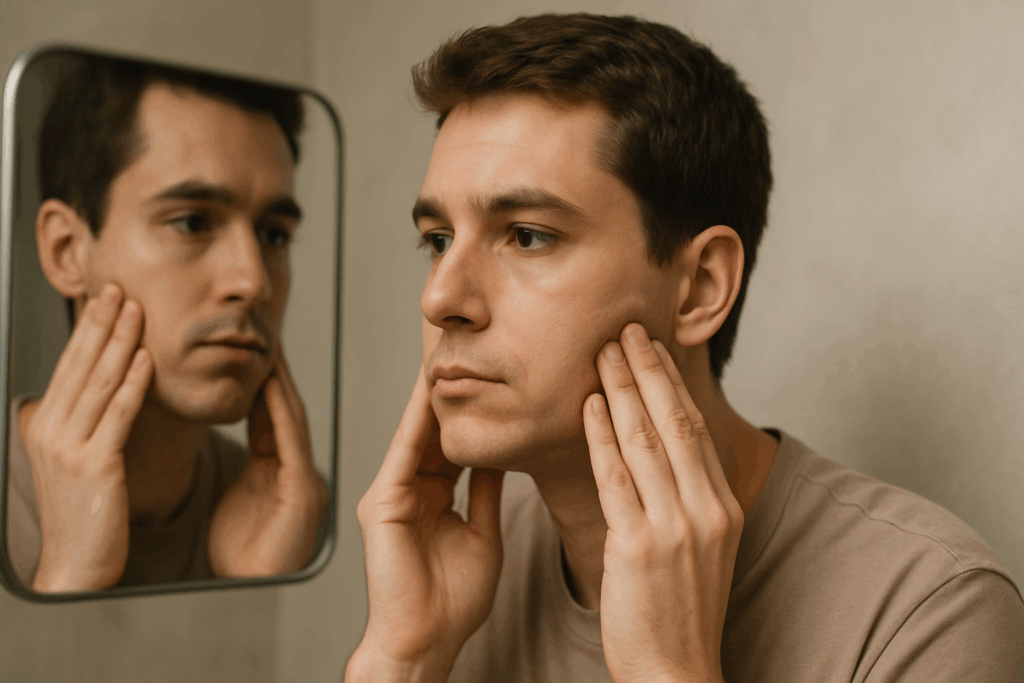
Early Signs: Why Is My Face Sagging at 20 or 30?
The distressing realization that “my face is sagging at 20” or “my face is sagging in my 30s” is becoming increasingly common. Shifts in lifestyle, environmental exposures, and global health patterns contribute to these earlier signs of aging. Excessive screen time, for instance, has introduced a phenomenon termed “tech neck,” wherein repeated downward gaze at devices accelerates sagging along the jawline and neck.
Moreover, chronic dehydration, high levels of cortisol from stress, and diets high in processed foods lead to inflammatory responses within the skin, reducing its regenerative capabilities. In individuals who smoke or live in heavily polluted urban environments, oxidative damage is further compounded, resulting in saggy skin on the face far earlier than would be expected naturally.
Recognizing these early warning signs—such as loss of cheek volume, a softer jawline, and subtle forehead sagging—provides an opportunity for early intervention. Starting appropriate skincare routines, focusing on skin nutrition, and considering preventive treatments like microneedling or radiofrequency therapy can help restore facial firmness before sagging becomes more pronounced.

Understanding and Preventing Facial Sagging Through Lifestyle Adjustments
One of the most potent tools in preventing sagging facial skin lies within daily lifestyle choices. Implementing small but consistent changes can yield profound effects over the long term.
A diet rich in antioxidants—such as vitamins C, E, and A—helps neutralize free radicals that contribute to collagen degradation. Incorporating protein-rich foods provides essential amino acids necessary for collagen synthesis, thereby maintaining the skin’s structural integrity. Hydration also plays a critical role: water supports skin cell function and helps maintain dermal plumpness, minimizing the risk of saggy cheeks.
Moreover, adopting a regular sleep schedule ensures optimal hormonal balance and skin repair. Growth hormone, which peaks during deep sleep, stimulates collagen production and aids in skin regeneration. Stress management techniques such as meditation and yoga help lower cortisol levels, preserving skin elasticity. Understanding and preventing facial sagging through lifestyle modifications is not only effective but also accessible to anyone willing to invest in their long-term skin health.
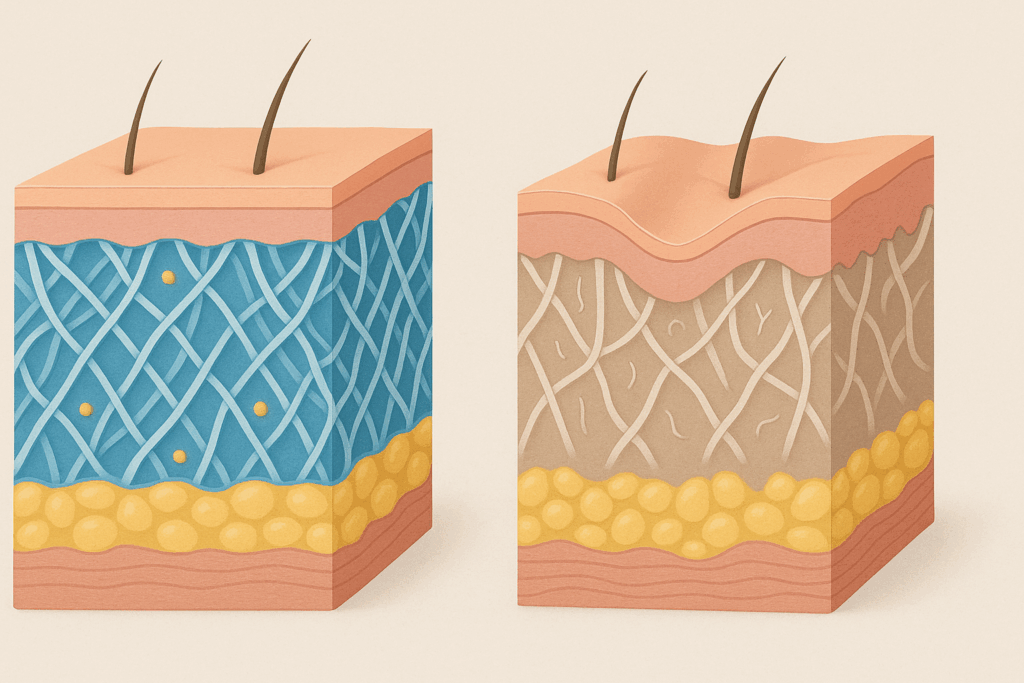
The Science of What Causes Loose Skin and What Makes Skin Sag
Loose skin and sagging facial contours are rooted in intricate biological processes that extend beyond the surface. Aging fibroblasts—the cells responsible for producing collagen and elastin—become less active over time. Simultaneously, the skin’s natural production of hyaluronic acid, which retains moisture, decreases, leading to a loss of skin turgor and resilience.
Hormonal changes, particularly the decline of estrogen during menopause, have also been implicated in accelerating skin laxity. Estrogen promotes collagen synthesis and maintains skin thickness; thus, its depletion leads to thinner, more fragile skin susceptible to sagging. In men, the gradual decline of testosterone similarly influences skin firmness, although typically at a slower rate.
Mechanical factors also contribute to sagging. Repetitive facial expressions, gravitational pull, and even habitual sleeping positions can all cause mechanical stretching of the skin over time, exacerbating saggy skin on the face. Understanding these mechanisms deepens appreciation for the multidimensional nature of facial aging and highlights the necessity of a comprehensive, multifaceted approach to prevention.
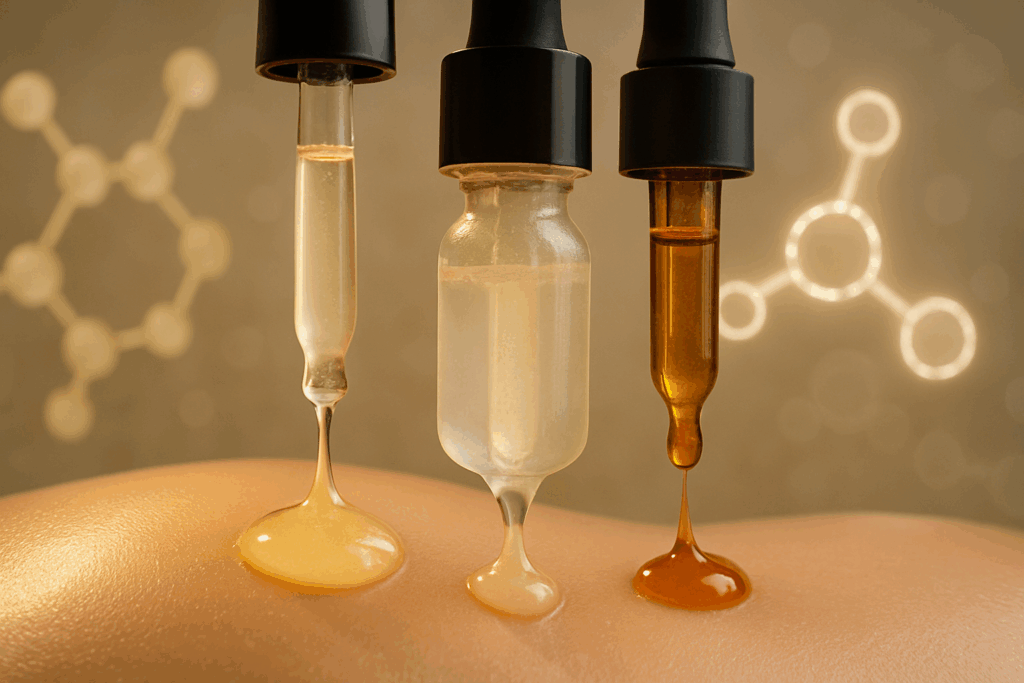
Understanding and Preventing Facial Sagging with Topical Skincare Innovations
Topical skincare remains a cornerstone in the effort toward understanding and preventing facial sagging. Advances in cosmetic science have introduced a plethora of ingredients capable of stimulating collagen production, improving elasticity, and restoring dermal architecture.
Retinoids, derived from vitamin A, are among the most extensively studied compounds for combating sagging facial skin. They work by accelerating cell turnover and stimulating fibroblasts to produce new collagen. Similarly, peptides—small chains of amino acids—serve as signaling molecules that encourage the skin to repair and strengthen itself.
Antioxidant-rich serums, especially those containing stabilized vitamin C, not only protect against oxidative stress but also directly stimulate collagen synthesis. Growth factors derived from bioengineered sources or plant extracts provide an additional layer of regenerative support, mimicking the body’s natural healing processes.
Regular exfoliation with alpha hydroxy acids (AHAs) also promotes healthier, thicker skin by removing dead cells that dull the complexion and by encouraging new, more resilient skin growth. By integrating scientifically validated topical agents into a daily regimen, individuals can meaningfully delay the onset of a saggy face and maintain firmer, more youthful contours.
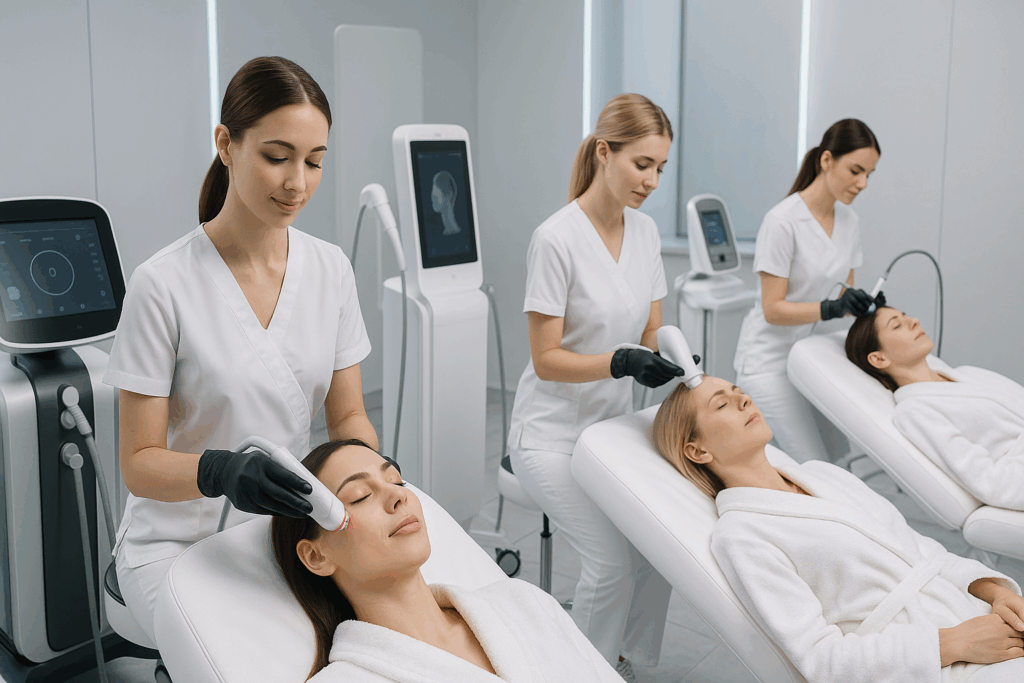
The Impact of Technology: How to Stop Face Sagging with Non-Surgical Treatments
Modern technology offers an impressive array of non-invasive options for those wondering how to stop face sagging without resorting to surgery. Radiofrequency (RF) devices deliver energy deep into the dermis, heating tissues to stimulate collagen remodeling. Over a series of treatments, RF therapy can lead to noticeable skin tightening and improved facial definition.
Ultrasound-based treatments, such as Ultherapy, target deeper layers of the skin and connective tissues, inducing controlled thermal injury that triggers a robust regenerative response. The result is gradual lifting and firming, particularly effective for sagging face at 30 or 40 years of age.
Microneedling, particularly when combined with radiofrequency or platelet-rich plasma (PRP), introduces controlled micro-injuries that stimulate collagen and elastin production. Red light therapy, meanwhile, enhances mitochondrial activity in skin cells, boosting energy production and encouraging more youthful skin function.
Understanding and preventing facial sagging now increasingly involves leveraging these advanced therapies in combination with traditional skincare practices, creating a comprehensive strategy to stave off the visible signs of aging.
FAQ: Expert Answers for Understanding and Preventing Facial Sagging
What are some uncommon causes of face sagging in younger individuals?
Many people wonder, “Why is my face sagging at 20?” while assuming aging is the sole factor. However, rapid weight loss, eating disorders, and hormonal imbalances such as hypothyroidism can contribute to a saggy face much earlier than expected. Excess cortisol, a stress hormone, can accelerate collagen breakdown, especially in high-stress individuals. Poor lymphatic drainage is another overlooked issue; if the face isn’t detoxifying well, puffiness and eventual facial sagging may occur. Furthermore, lack of facial muscle tone due to sedentary expressions and overexposure to screens can aggravate sagging facial skin.
How does poor posture contribute to sagging facial skin over time?
Posture plays a surprisingly vital role in maintaining youthful facial structure. Slouching and forward head posture put excess tension on the platysma muscle and jawline, contributing to sagging face features, especially in the neck and lower cheeks. This mechanical strain, combined with gravity, weakens supportive tissues and leads to premature signs of facial sagging. With the rise of smartphones and laptop use, this posture-induced saggy skin on face areas is now being seen in people as young as their twenties. Corrective exercises and mindfulness of posture can help slow down this trajectory.
Understanding and Preventing Facial Sagging: Can facial exercises make a difference?
Yes, when performed consistently and correctly, facial exercises can enhance muscle tone and potentially delay a saggy face. These exercises target the deeper facial muscles, increasing circulation and collagen stimulation in the process. Techniques like resistance-based cheek lifts or jawline tightening routines may prevent sagging cheeks and forehead sagging. However, overdoing these exercises or using poor technique can actually cause dynamic wrinkles or exacerbate sagging skin face issues. Balance, education, and gradual integration are key to achieving safe and effective results.
Are certain sleep positions linked to premature sagging facial skin?
Absolutely. Sleeping on your side or stomach exerts prolonged pressure on one side of the face, compressing tissues and contributing to asymmetry and saggy cheeks. Over years, this repeated compression leads to sleep lines, facial distortion, and increased laxity in sagging facial skin. Transitioning to back-sleeping can help reduce this risk, especially when paired with silk or satin pillowcases that minimize friction. Sleep position is a practical, low-cost method for how to prevent cheeks from sagging long term.
Understanding and Preventing Facial Sagging: What innovations are on the horizon?
The future of how to stop face sagging is being shaped by regenerative technologies and bioactive compounds. Advances in stem cell-based serums, nano-liposome delivery systems, and exosome therapy show promise for restoring skin firmness at the cellular level. These innovations could target what makes skin sag by stimulating intrinsic repair mechanisms and rebuilding structural integrity. Additionally, AI-driven diagnostic tools are being developed to predict facial aging trends based on genetics and lifestyle, allowing for hyper-personalized treatments. This merging of science and aesthetics is redefining the approach to saggy skin conditions.
How does psychological stress impact sagging facial skin?
Chronic psychological stress not only elevates cortisol, which degrades collagen, but also depletes essential nutrients that support dermal health. People under long-term stress often show signs of facial sagging earlier due to inflammation, poor sleep, and poor self-care habits. Stress accelerates the appearance of a sagging face at 30 or even earlier, creating a visible mismatch between internal age and external appearance. Meditation, therapy, and lifestyle rebalancing are key interventions to reduce this hidden contributor to sagging skin face concerns. Prioritizing mental health is thus integral to holistic anti-aging strategies.
What is the connection between bone loss and sagging face features?
As we age, our facial bones—particularly the maxilla and mandible—gradually lose density. This bone recession diminishes the scaffolding that supports the skin and muscles, contributing to saggy forehead areas, hollow cheeks, and jawline droop. Even in younger individuals, vitamin D deficiency or low calcium intake can initiate early facial bone loss, exacerbating why my face sagging questions in seemingly healthy adults. Bone-preserving supplements, weight-bearing exercise, and posture maintenance can help preserve facial structure integrity. Addressing skeletal aging is a vital layer of understanding and preventing facial sagging holistically.
Is there a link between gut health and sagging facial skin?
Emerging research suggests the gut-skin axis plays a crucial role in dermal integrity. Poor gut health can lead to systemic inflammation, affecting skin elasticity and contributing to saggy skin on face areas. Nutrient malabsorption also impacts collagen synthesis, which may explain why some individuals develop sagging skin face symptoms despite good topical care. Probiotic-rich diets and digestive enzyme support can restore gut balance and promote healthier, firmer skin. Recognizing the gut’s role expands the understanding of what causes sagging skin from an inside-out perspective.
Can medical-grade tools used at home actually reduce facial sagging?
Yes, with proper use and consistency, at-home medical devices such as microcurrent wands, LED light therapy masks, and radiofrequency tools can complement professional treatments. These devices stimulate collagen and elastin production, combat saggy skin conditions, and support daily maintenance of facial tone. It’s essential, however, to use high-quality, FDA-cleared tools and follow usage guidelines to prevent misuse or overexposure. These home interventions are an effective part of how to avoid saggy face deterioration between clinic visits. When combined with a disciplined skincare regimen, they can offer visible, measurable improvements.
How should skincare evolve with age to combat a sagging face at 40?
The approach to skincare must shift dramatically by the fourth decade of life. While younger individuals can focus on prevention, those dealing with a sagging face at 40 need intensive correction strategies. Products should now include peptides, growth factors, and retinoids, combined with ingredients that boost hyaluronic acid and reinforce the skin barrier. A comprehensive protocol includes double cleansing, active serums, microexfoliation, and consistent sunscreen use to tackle the causes of saggy skin and rejuvenate sagging facial skin. As the skin’s metabolism slows, layering techniques and high-potency formulas become critical in reversing the signs of a mature and saggy complexion.
Embracing Science and Self-Care: A Holistic Conclusion on Understanding and Preventing Facial Sagging
As we journey through the science, genetics, lifestyle factors, and modern interventions related to facial aging, one message becomes abundantly clear: understanding and preventing facial sagging is not merely a cosmetic endeavor—it is a proactive pursuit of long-term skin vitality, confidence, and health. The earlier we begin to engage with the underlying mechanisms that cause sagging skin on the face, the more empowered we become to delay its progression and preserve our youthful appearance for years to come.
Facial sagging, whether it manifests as saggy cheeks in your twenties or a droopy jawline in your forties, is a multifaceted phenomenon. It reflects not only the passage of time but also the cumulative effects of stress, sun exposure, hormonal shifts, nutrition, sleep, and even posture. Asking questions like “Why is my face sagging at 20?” or “What makes skin sag in my thirties?” is not a reflection of vanity—it is a sign of awareness in an age where preventative care is more accessible than ever.
Crucially, while genetics may establish a foundational predisposition, they do not determine destiny. Advances in dermatological science, from collagen-boosting skincare to cutting-edge technologies like radiofrequency and ultrasound therapy, offer tangible tools for those seeking how to fix a droopy face or avoid the sagging skin condition altogether. Combined with intentional lifestyle choices—nutrient-rich diets, stress regulation, hydration, and sun protection—these options allow for a comprehensive, strategic response to early signs of sagging facial skin.
It is also essential to shift the narrative surrounding facial aging. Rather than viewing sagging face features as failures to maintain youth, we can understand them as messages from our body—indicators that deeper processes, such as collagen loss or oxidative damage, are at play. By listening to these signals and responding with care and science-backed action, we can address the root causes of saggy skin on the face rather than masking the symptoms alone.
For those navigating concerns about why their face may be sagging in their 30s, or seeking how to prevent cheeks from sagging before these signs emerge, the path forward is both scientific and self-affirming. Prevention is not about stopping time—it is about optimizing biology, harnessing innovation, and embracing a lifestyle that supports the skin’s natural architecture. Facial integrity, after all, is not just about smoothness or symmetry—it is a reflection of cellular resilience, hormonal harmony, and overall well-being.
In embracing this holistic framework—where internal balance meets external science—we do more than learn how to stop face sagging. We learn how to support our skin as a living, dynamic system capable of repair, adaptation, and renewal. Understanding and preventing facial sagging is therefore not just an anti-aging goal; it is a long-term investment in ourselves, rooted in knowledge, compassion, and the power of proactive care.
Further Reading:
Many ways to firm sagging skin